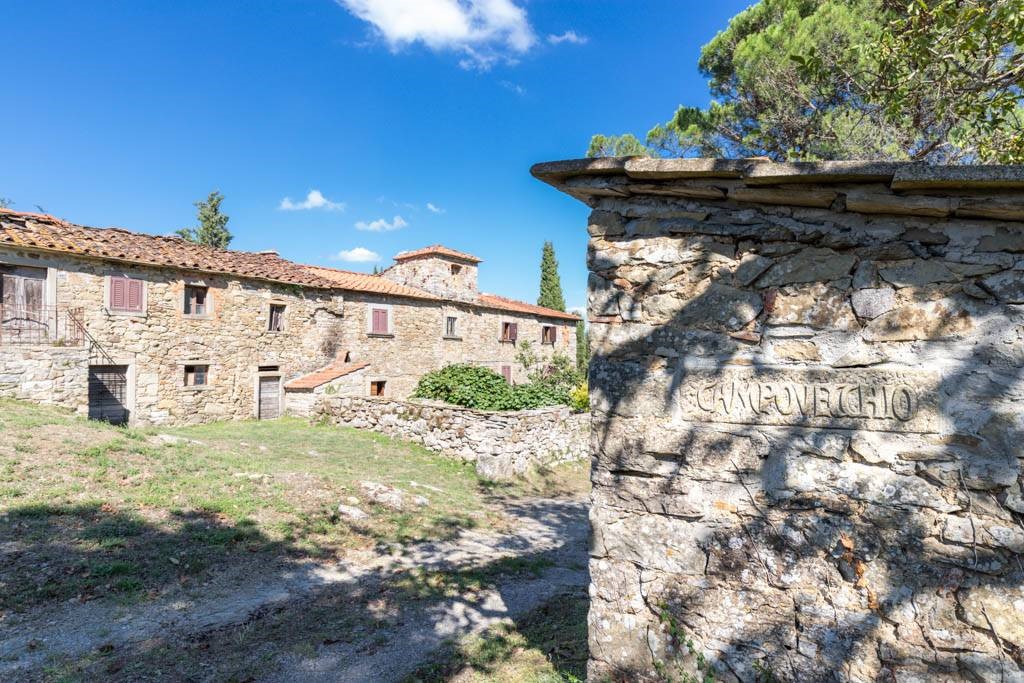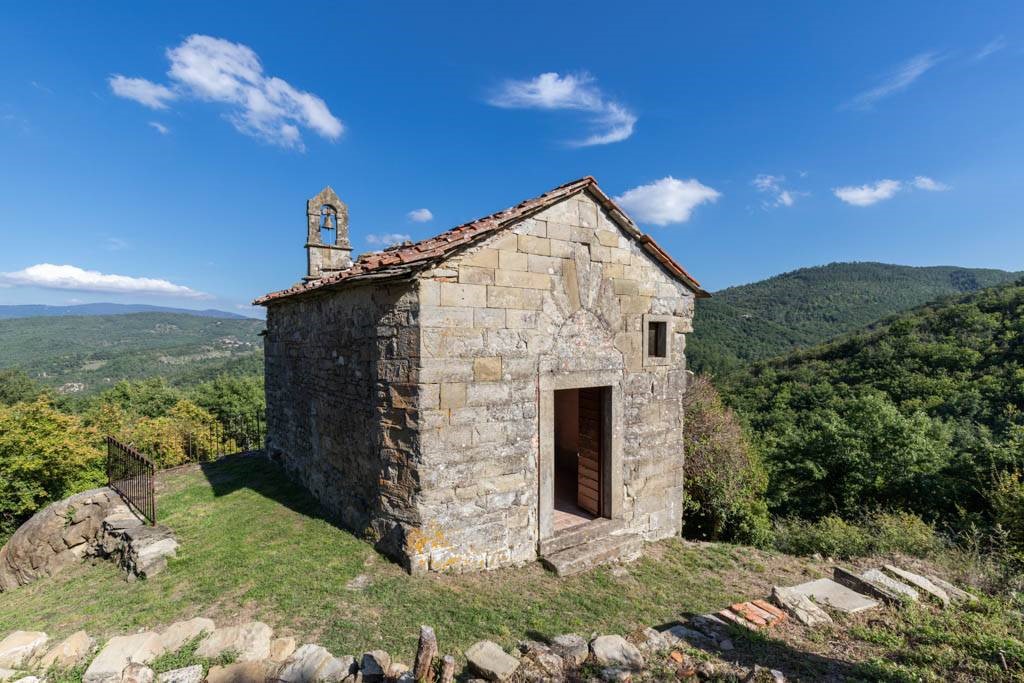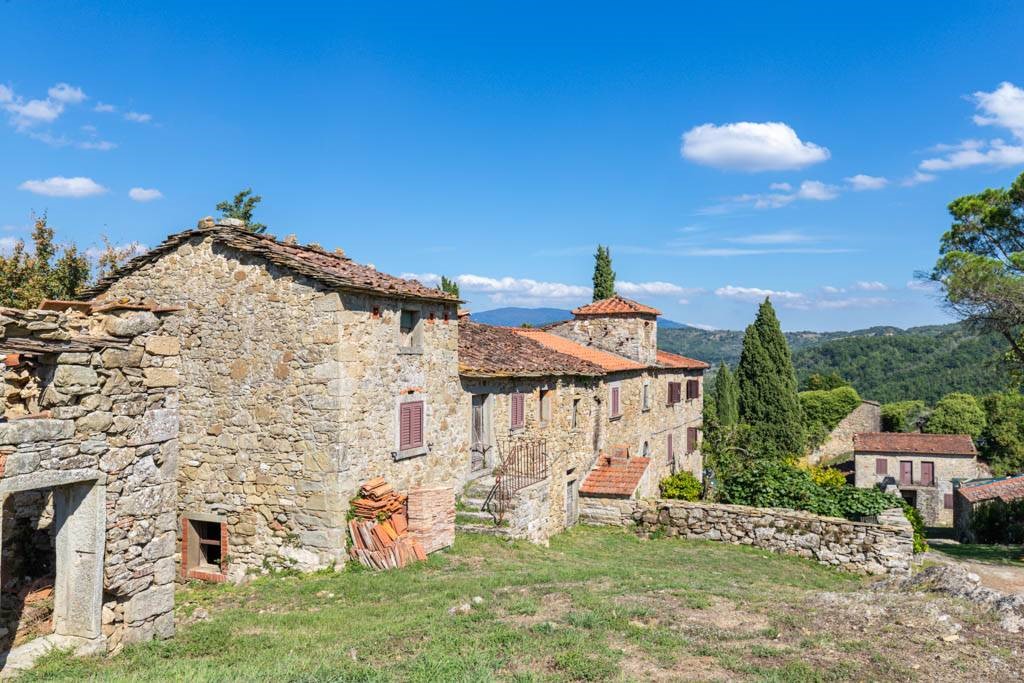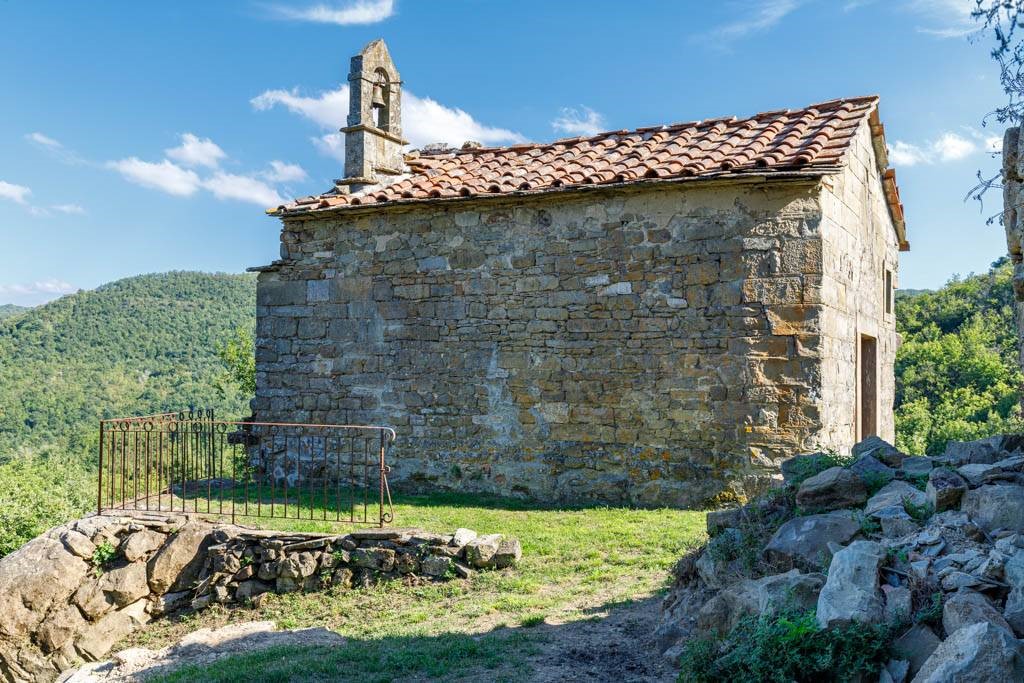PICTURES ARE LOADING...
House & single-family home for sale in Talla
USD 2,354,578
House & Single-family home (For sale)
23,681 sqft
lot 11,840,301 sqft
Reference:
EDEN-T90062588
/ 90062588
Campovecchio is a locality of the Talla commune in the Arezzo province located in the heart of Casentino National Park along the roads that lead to the Pratomagno Massif and to the Crocina Wall, one of the most uncontaminated places in Tuscany. Here, the connection with nature is preponderant: The greens and many other colors from the agriculture downhill, which give space to the oak woodlands and beech trees that rise up and disappear into the mountains grassy ridge. In this scene, little villages erect, including the two big vivid centers of Camaldoli and the Verna. It is amongst these landscapes that Leonardo Da Vinci seems to have painted Monalisa. The village, momentarily uninhabited, is composed of a main building that probably englobed the Ancient Roman castle, and another eight buildings habitable or accessorized that are all in need of restructuring action. Built on a rocky spur that elevates from a convergence of the Lavanzone e Crognolino creeks, the first building was most likely a church dating back to around 1100, dedicated to the Saint Appollinare. Therefore, the church of Roman times, has one window situated in the center of the apse of Byzantine origin, of which in May, light enters directly from the sun, illuminating the entire interior. The bronze bell nestled in the bell-tower, original from 1000, stroking its chimes until they are lost into the valley. The places charm grows all around the church, which rests on just one boulder of stone. The houses lay along the oldest road that connected the Cassia Vetus of Valdarno to Flaminia Minor and all the way down towards Ancient Rome, and to where all the towns constructions are connected to. The name Campovecchio seems to derive from an old military language most likely due to the presence of a military station of the Byzantines that once descended from Casentine-Romagnol Appennines and had created a series of armed outposts on the Pratomagno ridge, thus controlling many transit routes in order to fight against the longboard tribes advancing. The place is surrounded by forests and agricultural land properties for a total of 112 hectares, nourished by a water spring that flows into the property with a constantly during the twelve-month span. It is situated about half an hour from Arezzo or from the highway exit A1 Valdarno, at about one hour from Florence and Siena. The main access street is private and of exclusive use. It is found only 15 minutes away by car from the stunning Relais II Borro propriety of the Ferragamo family, goal of horse-riding, gold, and spa enthusiasts. It is a place where time doesnt seem to go by, where natures sounds surmount thoughts and where the perceived mysticism is the product of the passing history that has left uncontaminated the nature around.
View more
View less
Campovecchio ist ein Ort der Gemeinde Talla in der Provinz Arezzo im Herzen des Nationalparks Casentino entlang der Straßen, die zum Pratomagno-Massiv und zur Crocina-Mauer führen, einem der unberührtesten Orte der Toskana. Hier überwiegen die Verbindung zur Natur: Die Grüns und viele andere Farben von der Landwirtschaft bergab, die den Eichenwäldern und Buchen, die sich erheben und im Grasgras der Berge verschwinden, Raum geben. In dieser Szene errichten sich kleine Dörfer, darunter die beiden großen lebhaften Zentren Camaldoli und die Verna. Unter diesen Landschaften scheint Leonardo Da Vinci Monalisa gemalt zu haben. Das Dorf, das vorübergehend unbewohnt ist, besteht aus einem Hauptgebäude, das wahrscheinlich die antike römische Burg umschloss, und weiteren acht bewohnbaren oder ausgestatteten Gebäuden, die alle Umstrukturierungsmaßnahmen erfordern. Erbaut auf einem Felsvorsprung, der sich aus einer Konvergenz der Bäche Lavanzone e Crognolino erhebt, war das erste Gebäude höchstwahrscheinlich eine Kirche aus der Zeit um 1100, die dem Heiligen Appollinare gewidmet war. Daher hat die Kirche der Römerzeit ein Fenster in der Mitte der Apsis byzantinischen Ursprungs, von dem im Mai Licht direkt von der Sonne eintritt und das gesamte Innere beleuchtet. Die Bronzeglocke, eingebettet in den Glockenturm, ursprünglich aus dem Jahr 1000, streichelt ihre Glockenspiele, bis sie im Tal verloren gehen. Der Charme der Orte wächst rund um die Kirche, die auf nur einem Felsbrocken ruht. Die Häuser lagen entlang der ältesten Straße, die die Cassia Vetus des Valdarno mit Flaminia Minor und den ganzen Weg hinunter zum antiken Rom verband, mit dem alle Stadtbauten verbunden sind. Der Name Campovecchio scheint von einer alten Militärsprache abgeleitet zu sein, höchstwahrscheinlich aufgrund der Anwesenheit einer Militärstation der Byzantiner, die einst von Casentine-Romagnol Appennines abstammten und eine Reihe von bewaffneten Außenposten auf dem Pratomagno-Kamm geschaffen hatten, wodurch viele Transitrouten kontrolliert wurden, um gegen die vorrückenden Langbordstämme zu kämpfen. Der Ort ist von Wäldern und landwirtschaftlichen Grundstücken für insgesamt 112 Hektar umgeben, genährt von einer Wasserquelle, die während der zwölfmonatigen Zeit ständig in das Grundstück fließt. Es liegt etwa eine halbe Stunde von Arezzo oder von der Autobahnausfahrt A1 Valdarno, etwa eine Stunde von Florenz und Siena entfernt. Die Hauptzufahrtsstraße ist privat und von exklusiver Nutzung. Es ist nur 15 Autominuten vom atemberaubenden Relais II Borro der Familie Ferragamo entfernt, ziel der Reit-, Gold- und Spa-Enthusiasten. Es ist ein Ort, an dem die Zeit nicht zu vergehen scheint, wo Naturgeräusche Gedanken übersteigen und wo die wahrgenommene Mystik das Produkt der vorbeiziehenden Geschichte ist, die die Natur unberührt gelassen hat.
Campovecchio è una località del Comune di Talla in provincia di Arezzo collocata nel cuore del Parco Nazionale del Casentino, lungo le vie che conducono al massiccio di Pratomagno e al Vallo della Crocina, uno dei luoghi più incontaminati della Toscana. Qui il rapporto con la natura è preponderante: il verde e i tanti altri colori delle culture agricole che si trovano a valle, danno spazio ai boschi di querce e faggi che si innalzano fino a scomparire poi nel crinale erboso della montagna. In questo scenario si ergono piccoli borghi nonché i due grandi centri spirituali di Camaldoli e La Verna. È tra questi paesaggi che Leonardo da Vinci sembra aver dipinto la Monalisa Il Borgo, al momento disabitato, è composto da un edificio principale, che probabilmente ha inglobato il vecchio castello romanico, e da altri otto edifici tra abitativi e accessori che necessitano tutti di un intervento di ristrutturazione; è stato edificato su uno sperone di roccia che si eleva dalla confluenza dei torrenti Lavanzone e Crognolino, in cui il primo edificio probabilmente era una chiesa risalente al 1100 circa, dedicata a Santa Apollinare. La Chiesa, quindi di epoca romanica, presenta una sola finestra posta al centro dellabside di origine Bizantina dalla quale, nel mese di maggio, entra la luce diretta del sole, illuminando completamente linterno. La campana di bronzo incastonata nel campanile originale del 1000 lancia i suoi rintocchi a perdersi nella valle. Il fascino del luogo cresce tutto intorno alla Chiesa appoggiata su un unico masso di pietra. Le case si sviluppano lungo lantichissima strada che collegava la Cassia Vetus del Valdarno alla Flaminia Minor e scendeva a basso verso Roma Antica; tutte le costruzioni del borgo sono ad essa collegate. Il nome Campovecchio sembra derivi da un vecchio linguaggio militare, probabilmente dovuto alla presenza di uno stanziamento militare dei Bizantini che, scesi dallAppennino casentinese-romagnolo, avevano creato una serie di avamposti armati sul crinale del Pratomagno, controllando varie vie di transito nel tentativo di contrastare lavanzata delle tribù longobarde. Il luogo è circondato da boschi e terreni agricoli di proprietà, per un totale di 112 ettari, alimentato da una sorgente di acqua che sgorga anchessa nella proprietà con portata costante nellarco dei dodici mesi. È situato a circa mezzora da Arezzo, altrettanto dalluscita dellautostrada A1 Valdarno, a circa unora da Firenze e da Siena. La strada principale di accesso è privata e di uso esclusivo. Si trova a soli 15 minuti di auto dal bellissimo Relais Il Borro di proprietà della famiglia Ferragamo, meta degli amanti dellEquitazione, del Golf e del Benessere. È un luogo dove ci si sente fuori dallo scorrere del tempo, dove i rumori della natura sovrastano i pensieri e la misticità che si avverte è il prodotto dello scorrere della storia che ha lasciato incontaminata la natura intorno.
Campovecchio is a locality of the Talla commune in the Arezzo province located in the heart of Casentino National Park along the roads that lead to the Pratomagno Massif and to the Crocina Wall, one of the most uncontaminated places in Tuscany. Here, the connection with nature is preponderant: The greens and many other colors from the agriculture downhill, which give space to the oak woodlands and beech trees that rise up and disappear into the mountains grassy ridge. In this scene, little villages erect, including the two big vivid centers of Camaldoli and the Verna. It is amongst these landscapes that Leonardo Da Vinci seems to have painted Monalisa. The village, momentarily uninhabited, is composed of a main building that probably englobed the Ancient Roman castle, and another eight buildings habitable or accessorized that are all in need of restructuring action. Built on a rocky spur that elevates from a convergence of the Lavanzone e Crognolino creeks, the first building was most likely a church dating back to around 1100, dedicated to the Saint Appollinare. Therefore, the church of Roman times, has one window situated in the center of the apse of Byzantine origin, of which in May, light enters directly from the sun, illuminating the entire interior. The bronze bell nestled in the bell-tower, original from 1000, stroking its chimes until they are lost into the valley. The places charm grows all around the church, which rests on just one boulder of stone. The houses lay along the oldest road that connected the Cassia Vetus of Valdarno to Flaminia Minor and all the way down towards Ancient Rome, and to where all the towns constructions are connected to. The name Campovecchio seems to derive from an old military language most likely due to the presence of a military station of the Byzantines that once descended from Casentine-Romagnol Appennines and had created a series of armed outposts on the Pratomagno ridge, thus controlling many transit routes in order to fight against the longboard tribes advancing. The place is surrounded by forests and agricultural land properties for a total of 112 hectares, nourished by a water spring that flows into the property with a constantly during the twelve-month span. It is situated about half an hour from Arezzo or from the highway exit A1 Valdarno, at about one hour from Florence and Siena. The main access street is private and of exclusive use. It is found only 15 minutes away by car from the stunning Relais II Borro propriety of the Ferragamo family, goal of horse-riding, gold, and spa enthusiasts. It is a place where time doesnt seem to go by, where natures sounds surmount thoughts and where the perceived mysticism is the product of the passing history that has left uncontaminated the nature around.
Campovecchio is een plaats in de gemeente Talla in de provincie Arezzo, gelegen in het hart van het Nationaal Park Casentino langs de wegen die leiden naar het Pratomagno-massief en naar de Crocina-muur, een van de meest ongerepte plaatsen in Toscane. Hier overheerst de verbinding met de natuur: De greens en vele andere kleuren uit de landbouw bergafwaarts, die ruimte geven aan de eikenbossen en beukenbomen die oprijzen en verdwijnen in de bergen grasrug. In deze scène ontstaan kleine dorpjes, waaronder de twee grote levendige centra van Camaldoli en de Verna. Het is tussen deze landschappen dat Leonardo Da Vinci Monalisa lijkt te hebben geschilderd. Het dorp, tijdelijk onbewoond, bestaat uit een hoofdgebouw dat waarschijnlijk het oude Romeinse kasteel heeft omsloten, en nog eens acht bewoonbare of accessorized gebouwen die allemaal behoefte hebben aan herstructureringsacties. Gebouwd op een rotsachtige uitloper die uit een samenvloeiing van de Lavanzone e Crognolino kreken verheft, was het eerste gebouw hoogstwaarschijnlijk een kerk die dateert uit ongeveer 1100, gewijd aan de Heilige Appollinare. Daarom heeft de kerk uit de Romeinse tijd één raam in het midden van de apsis van Byzantijnse oorsprong, waarvan in mei het licht rechtstreeks vanuit de zon binnenkomt en het hele interieur verlicht. De bronzen klok genesteld in de klokkentoren, oorspronkelijk uit 1000, streelt zijn klokkenspel totdat ze verloren gaan in de vallei. De charme van de plaatsen groeit rondom de kerk, die rust op slechts één rotsblok van steen. De huizen liggen langs de oudste weg die de Cassia Vetus van Valdarno verbond met Flaminia Minor en helemaal naar beneden richting het oude Rome, en waar alle steden constructies mee verbonden zijn. De naam Campovecchio lijkt te zijn afgeleid van een oude militaire taal, waarschijnlijk vanwege de aanwezigheid van een militaire post van de Byzantijnen die ooit afstamde van Casentine-Romagnol Appennijnen en een reeks gewapende buitenposten op de Pratomagno-bergkam had gecreëerd, waardoor vele doorvoerroutes werden gecontroleerd om te vechten tegen de longboardstammen die oprukten. De plaats is omgeven door bossen en landbouwgronden voor een totaal van 112 hectare, gevoed door een waterbron die in het pand stroomt met een constante gedurende de periode van twaalf maanden. Het ligt op ongeveer een half uur van Arezzo of van de afrit van de snelweg A1 Valdarno, op ongeveer een uur van Florence en Siena. De hoofdtoegangsstraat is privé en van exclusief gebruik. Het ligt op slechts 15 minuten rijden met de auto van het prachtige Relais II Borro-eigendom van de familie Ferragamo, doel van paardrijden, goud en spa-liefhebbers. Het is een plek waar de tijd niet voorbij lijkt te gaan, waar de natuur gedachten overstijgt en waar de waargenomen mystiek het product is van de voorbijgaande geschiedenis die de natuur om zich heen onbesmette heeft gelaten.
Campovecchio est une localité de la commune de Talla dans la province d’Arezzo située au cœur du parc national du Casentino le long des routes qui mènent au massif de Pratomagno et au mur de Crocina, l’un des endroits les plus non contaminés de Toscane. Ici, le lien avec la nature est prépondérant: les verts et bien d’autres couleurs de l’agriculture en descente, qui donnent de la place aux forêts de chênes et de hêtres qui s’élèvent et disparaissent dans les montagnes de la crête herbeuse. Dans cette scène, de petits villages s’érigent, y compris les deux grands centres vivants de Camaldoli et la Verna. C’est parmi ces paysages que Léonard de Vinci semble avoir peint Monalisa. Le village, momentanément inhabité, est composé d’un bâtiment principal qui englobe probablement l’ancien château romain, et de huit autres bâtiments habitables ou accessoirisés qui ont tous besoin d’une action de restructuration. Construit sur un éperon rocheux qui s’élève à partir d’une convergence des ruisseaux Lavanzone e Crognolino, le premier bâtiment était très probablement une église datant d’environ 1100, dédiée à la Sainte Appollinare. Par conséquent, l’église de l’époque romaine a une fenêtre située au centre de l’abside d’origine byzantine, dont en mai, la lumière entre directement du soleil, illuminant tout l’intérieur. La cloche de bronze nichée dans le clocher, originale de 1000, caressant ses carillons jusqu’à ce qu’ils soient perdus dans la vallée. Le charme des lieux grandit tout autour de l’église, qui repose sur un seul rocher de pierre. Les maisons se trouvaient le long de la plus ancienne route qui reliait la Cassia Vetus de Valdarno à Flaminia Minor et jusqu’à la Rome antique, et à laquelle toutes les constructions de la ville sont connectées. Le nom Campovecchio semble dériver d’une ancienne langue militaire probablement en raison de la présence d’une station militaire des Byzantins qui descendait autrefois des Apennins casentins-romagnols et avait créé une série d’avant-postes armés sur la crête de Pratomagno, contrôlant ainsi de nombreuses routes de transit afin de lutter contre les tribus de longboard qui avançaient. L’endroit est entouré de forêts et de propriétés agricoles pour un total de 112 hectares, nourris par une source d’eau qui se jette dans la propriété avec une durée constante pendant les douze mois. Il est situé à environ une demi-heure d’Arezzo ou de la sortie d’autoroute A1 Valdarno, à environ une heure de Florence et de Sienne. La rue principale d’accès est privée et à usage exclusif. Il se trouve à seulement 15 minutes en voiture de la magnifique propriété Relais II Borro de la famille Ferragamo, objectif des amateurs d’équitation, d’or et de spa. C’est un endroit où le temps ne semble pas passer, où les sons de la nature surmontent les pensées et où le mysticisme perçu est le produit de l’histoire passagère qui a laissé intacte la nature autour.
Reference:
EDEN-T90062588
Country:
IT
City:
Talla
Postal code:
52010
Category:
Residential
Listing type:
For sale
Property type:
House & Single-family home
Property size:
23,681 sqft
Lot size:
11,840,301 sqft
Rooms:
30





